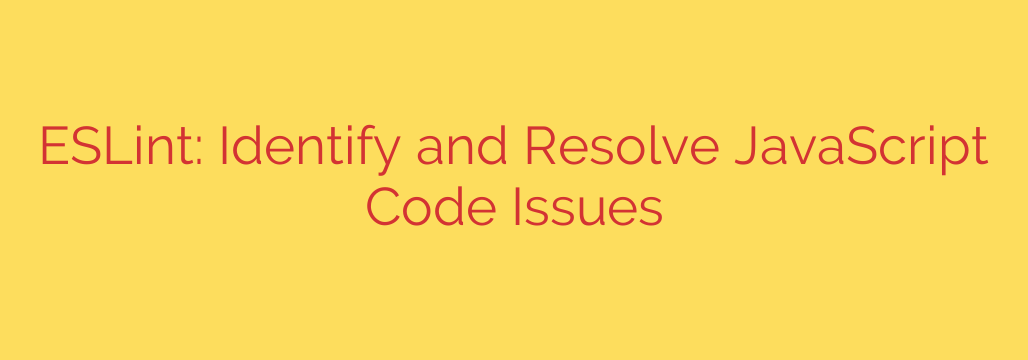
What is ESLint? Your Guide to Writing Cleaner, More Consistent JavaScript
In modern web development, writing clean, error-free, and maintainable code is not just a preference—it’s a necessity. As projects grow in complexity and teams expand, maintaining a consistent coding standard becomes a major challenge. This is where a powerful tool called ESLint comes into play, acting as your team’s automated code reviewer.
ESLint is a static code analysis tool for identifying and reporting on problematic patterns found in JavaScript code. Think of it as a grammar and spell checker for your programming. It examines your code without executing it and flags everything from potential syntax errors to stylistic inconsistencies, helping you write better code before it ever reaches production.
Why You Should Use ESLint in Every Project
Integrating ESLint into your development workflow isn’t just about enforcing rules; it’s about fundamentally improving the quality and reliability of your software. The benefits are immediate and impactful.
- Catch Errors Early: ESLint can identify common coding mistakes that lead to bugs, such as using a variable before it’s declared or creating unreachable code. Finding these issues during development is far cheaper and easier than fixing them after they’ve been deployed.
- Enforce Consistent Code Style: Whether it’s the debate between tabs and spaces, single vs. double quotes, or the placement of curly braces, ESLint settles the argument. By adopting a shared configuration (like the popular style guides from Airbnb or Google), you ensure every developer on the team writes code that looks and feels the same, making it incredibly easy to read and maintain.
- Improve Overall Code Quality: Beyond simple style, ESLint can enforce best practices that prevent “code smells” and anti-patterns. It encourages you to write more efficient, readable, and future-proof code, elevating the skills of your entire team.
- Automate Code Formatting: When paired with a formatter like Prettier, ESLint can automatically fix many of the issues it finds. This saves countless hours of manual formatting and allows developers to focus on what truly matters: building great features.
How ESLint Works: A Look Under the Hood
The magic behind ESLint lies in its process of static analysis. When you run ESLint on a file, it performs a few key steps:
- Parsing: ESLint first uses a parser (like Espree, its default) to transform your JavaScript code into a data structure called an Abstract Syntax Tree (AST). An AST is a tree representation of your code’s structure.
- Traversal: It then traverses this tree, visiting each “node” (e.g., a function declaration, a variable, an
ifstatement). - Rule Application: As it visits each node, ESLint applies a set of configured rules. Each rule is a small piece of logic designed to inspect a specific code pattern. If a node violates a rule, ESLint records it.
- Reporting: Finally, ESLint compiles all the violations it found and presents them to you in a clear report, complete with the file name, line number, and rule that was broken.
This entire process is highly configurable. You can choose which rules to enable, disable, or customize to perfectly match your project’s requirements.
Getting Started with ESLint: A Practical Guide
Setting up ESLint in your project is straightforward. If you’re using Node.js and npm, you can get started in minutes.
Installation: First, install ESLint as a development dependency in your project.
npm install eslint --save-devConfiguration: Next, initialize an ESLint configuration file. The setup wizard makes this easy.
npx eslint --init
This command will ask you a series of questions about your project (e.g., Are you using React? Are you using TypeScript? What style guide do you want to follow?) and automatically generate a.eslintrc.jsconfiguration file for you.Integration with Your Editor: For the best experience, integrate ESLint directly into your code editor, such as VS Code. Simply install the official ESLint extension. This will provide real-time feedback directly in your editor, underlining problems as you type.
Running and Fixing: You can run ESLint from your terminal to check all your files.
npx eslint yourfile.js
Even better, you can use the--fixflag to automatically correct any rule violations that are fixable.
npx eslint . --fix
ESLint and Your Application’s Security
While not a dedicated security scanner, ESLint plays a valuable role in improving your application’s security posture. By flagging risky coding patterns, it can help prevent common vulnerabilities.
For example, specialized security plugins like eslint-plugin-security can detect:
- Use of
eval(): Usingeval()can expose your application to injection attacks. - Insecure Regular Expressions: Poorly written regex can be vulnerable to Regular Expression Denial of Service (ReDoS) attacks.
- Hardcoded Secrets: ESLint can be configured to warn against committing sensitive information like API keys directly into your code.
By enforcing secure coding practices at the earliest stage, ESLint acts as a first line of defense, helping you build more robust and resilient applications.
In conclusion, ESLint is an indispensable tool for any serious JavaScript developer. It fosters collaboration, prevents bugs, enforces high standards, and ultimately empowers you to write cleaner, safer, and more professional code. If you aren’t using it already, there’s no better time to start.
Source: https://www.linuxlinks.com/eslint-find-fix-problems-javascript-code/








